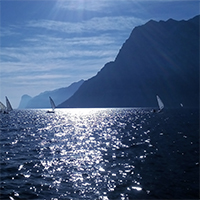Deep-mixing and deep-cooling events in Lake Garda: Simulation and mechanisms

All claims expressed in this article are solely those of the authors and do not necessarily represent those of their affiliated organizations, or those of the publisher, the editors and the reviewers. Any product that may be evaluated in this article or claim that may be made by its manufacturer is not guaranteed or endorsed by the publisher.
Authors
A calibrated three-dimensional numerical model (Delft3D) and in-situ observations are used to study the relation between deep-water temperature and deep mixing in Lake Garda (Italy). A model-observation comparison indicates that the model is able to adequately capture turbulent kinetic energy production in the surface layer and its vertical propagation during unstratified conditions. From the modeling results several processes are identified to affect the deep-water temperature in Lake Garda. The first process is thermocline tilting due to strong and persistent winds, leading to a temporary disappearance of stratification followed by vertical mixing. The second process is turbulent cooling, which acts when vertical temperature gradients are nearly absent over the whole depth and arises as a combination of buoyancy-induced turbulence production due to surface cooling and turbulence production by strong winds. A third process is differential cooling, which causes cold water to move from the shallow parts of the lake to deeper parts along the sloping bottom. Two of these processes (thermocline tilting and turbulent cooling) cause deep-mixing events, while deep-cooling events are mainly caused by turbulent cooling and differential cooling. Detailed observations of turbulence quantities and lake temperature, available at the deepest point of Lake Garda for the year 2018, indicate that differential cooling was responsible for the deep-water cooling at that location. Long-term simulations of deep-water temperature and deep mixing appear to be very sensitive to the applied wind forcing. This sensitivity is one of the main challenges in making projections of future occurrences of episodic deep mixing and deep cooling under climate change.
Edited by
Diego Fontaneto, CNR-IRSA Water Research Institute, Verbania, ItalySupporting Agencies
EOMORES projectHow to Cite

This work is licensed under a Creative Commons Attribution-NonCommercial 4.0 International License.






